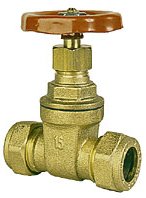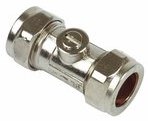Isolation/service valves in gravity feed plumbing systems
Turning off the incoming water at the main stopcock coming into a property will stop water flowing into the storage tanks.
However, it won't stop the water held in tanks from flowing to the appliances and outlets (i.e. a sink, bath or toilet cistern etc) until, eventually, the tanks have drained.
Being able to turn off the water from the tanks makes life so much easier when a tap washer needs to be replaced or the other parts of the system worked on.
If the supply cannot be turned off, the usual alternative is to drain the tanks completely.
Depending upon the age of the water system installed there may or may not be service valves (often referred to as isolation valves) along the pipework.
- Old plumbing systems will probably have no such valves,
- more modern systems may just have a valve located at the outlet from the cold and hot water tanks,
- really modern systems will probably have a service valve fitted near to each outlet/appliance as well as at the outlet from the tanks.
Gatevalves
 Valves fitted at the outlet of water tanks have traditionally been gatevalves (shown right) and are either located close to the cold water tank or in the pipework adjacent to the outlet from hot water tanks. If the valves cannot be located, check the pipework where it passes through the ceiling into the room below, sometimes they may be located in a cupboard or, if the pipeworkis boxed in, behind a cover held in place by screws. Gatevalves are turned off by turning the head clockwise.
Valves fitted at the outlet of water tanks have traditionally been gatevalves (shown right) and are either located close to the cold water tank or in the pipework adjacent to the outlet from hot water tanks. If the valves cannot be located, check the pipework where it passes through the ceiling into the room below, sometimes they may be located in a cupboard or, if the pipeworkis boxed in, behind a cover held in place by screws. Gatevalves are turned off by turning the head clockwise.
Isolation valves
 Valves fitted in modern systems are usually quarter turn valves (either handle or screwdriver operated) which are quite unobtrusive when fitted in the pipework. Quarter turn valves are open when the handle (or screwdriver slot) is in line with the valve, and closed when they are at rightangles.
Valves fitted in modern systems are usually quarter turn valves (either handle or screwdriver operated) which are quite unobtrusive when fitted in the pipework. Quarter turn valves are open when the handle (or screwdriver slot) is in line with the valve, and closed when they are at rightangles.
The differences
The traditional gatevalves can be unreliable as sometimes they let a small of water through even when fully closed or fail to open when they are turned anti-clockwise - where a gatevalve needs to be replaced, it is best to fit a quarter turn valve which are more reliable. Never fit a stopcock in a gravity feed system as they need a certain amount of water pressure to lift the washer from the seat and a gravity system may not have sufficient pressure.
Where a valve is not fitted anywhere along the pipe-run and the system needs to be worked on, the usual alternative is to turnoff the water supply to the tank, open the outlets, and drain down all the water. An alternative may be, with an open water tank, to block the outlet from within the tank by inserting a suitable sized cork in the outlet pipe.
Where a system has to be drained down, it is always worth adding a quarter turn service valve in the outlet from the tank while the system is drained down so that it can be avoided in future. Remember when working on old plumbing systems that a 15mm service valve will fit ½ inch copper pipe, but to fit a 22mm valve to ¾ inch pipe work is not straightforward.
